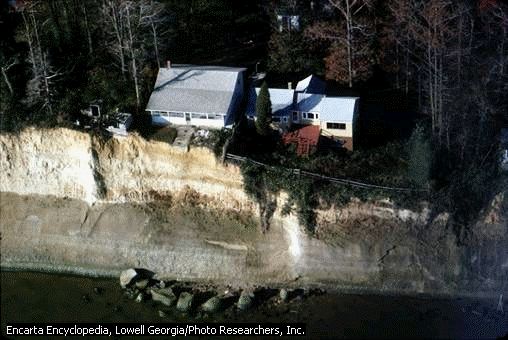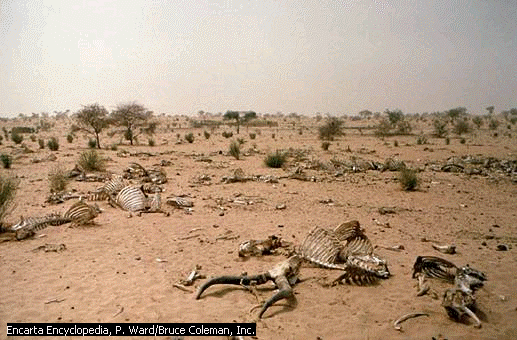HOME
EVENTS
Erosion
 Natural
forces such as wind, rain, and temperature cycles continually erode
the land. This Chesapeake Bay home was built on a cliff that has
undergone severe erosion. Many people battle erosion by planting
grass and trees to form a strong root system or laying down netting
to keep rock and soil from washing away.
Natural
forces such as wind, rain, and temperature cycles continually erode
the land. This Chesapeake Bay home was built on a cliff that has
undergone severe erosion. Many people battle erosion by planting
grass and trees to form a strong root system or laying down netting
to keep rock and soil from washing away.
Removal of rock and soil
material by natural processes, principally running water, glaciers,
waves, and wind is called erosion. Erosion transports rocky material
after the process of weathering has broken bedrock down into smaller,
moveable pieces.
Through erosion the surface
of the earth is constantly being sculptured into new forms. The
shapes of continents are continuously changing, as waves and tides
cut into old land while silt from rivers builds up new land. As
rivulets, streams, and rivers cut their channels deeper, gullies
become ravines and ravines become valleys. The Grand Canyon, more
than 1500 m (more than 5000 ft) deep, was produced by erosion
probably within the past 5 million years. The overall effect of the
wearing down of mountains and plateaus is to level the land; the
tendency is toward the reduction of all land surfaces to sea level.
For example, in each 7000- to 9000-year period the entire area
drained by the Mississippi River loses an average of 30 cm (12 in) of
altitude. Opposing this tendency are volcanic eruptions and movements
of the crust of the earth that raise mountains, plateaus, and new
islands. See Geology; Geomorphology.
WEATHERING
Weathering initiates the
erosion of rock, causing alterations in the surface layers. In dry
climates, the top layer of a rock may expand from the heat of the sun
and crack off from the lower layers. If the rock consists of several
minerals, the minerals may expand at different rates and break up the
rock. In cold climates, frost breaks up rocks because rainwater,
which seeps into cracks and pores in the rock, expands when it
freezes. Rain in damp climates acts chemically as well as
mechanically in the weathering of rocks. As the rain passes through
the atmosphere it absorbs carbon dioxide, forming carbonic acid,
which dissolves some minerals and decomposes others. Feldspar, a
common family of minerals in granite, is changed into clays, and
certain minerals in basalt combine with oxygen and water to form iron
oxides, such as limonite. Plants play a role in weathering as roots
can split rocks and extract soluble nutrients.
WATER EROSION
 After
the lush vegetation of a rain forest is removed, an area rarely
recovers. This deforested Costa Rican stream valley is eroding away
because there is no longer a good root system to anchor the topsoil
or decaying plant matter to replenish its nutrients. If the cycle
continues, the area may eventually resemble a desert.
After
the lush vegetation of a rain forest is removed, an area rarely
recovers. This deforested Costa Rican stream valley is eroding away
because there is no longer a good root system to anchor the topsoil
or decaying plant matter to replenish its nutrients. If the cycle
continues, the area may eventually resemble a desert.
Water plays an important role
in erosion by carrying away material that has been weathered and
broken down. When an area receives more water (in the form of rain,
melting snow, or ice) than the ground can absorb, the excess water
flows to the lowest level, carrying loose material with it. Gentle
slopes are subject to sheet and rill erosion, in which the runoff
removes a thin layer of topsoil without leaving visible traces on the
eroded surface. This erosion may be balanced by the formation of new
soil. Often, however, especially in arid areas having little
vegetation, the runoff leaves a pattern of gullies formed by
rivulets. Water can even erode solid rock, especially along
streambeds where the stones that are carried with the current scour
and abrade. Every year rivers deposit about 3.5 million tons of
eroded material into the oceans.
GLACIAL EROSION
Glaciers are important agents
of erosion. Although a glacier moves slowly, it gradually removes all
the loose material from the surface over which it travels, leaving
bare rock surfaces when the ice melts. Besides removing loose
material, glaciers actively erode the solid rock over which they
travel. Rock fragments that become embedded in the bottom and sides
of the moving ice mass act as an abrasive, grinding and scouring the
bedrock which forms the walls and floors of mountain valleys.
COASTAL EROSION
Coastal erosion of rocky
cliffs and sandy beaches results from the action of ocean waves and
currents. This is especially severe during storms. In many parts of
the world the loss of land due to coastal erosion represents a
serious problem. The action of waves, however, does not extend to a
great depth, and the sea tends to cut a flat platform, characteristic
of marine erosion, into coastal rocks.

During the
1930s, the southern Great Plains region of the U.S. known as the Dust
Bowl suffered severe wind erosion brought on by several years of
drought and overtillage. President Franklin Roosevelt’s New Deal
policy helped alleviate the financial losses, and new methods of land
conservation were implemented.
WIND EROSION
Wind is another active agent
of erosion, especially in arid climates with little vegetation. Wind
blowing across bare land lifts particles of sand and silt but leaves
behind larger pebbles and cobbles. Eventually, a surface layer of
closely packed stones, called a desert pavement, is formed as the
sand and silt is removed. The removal of large quantities of loose
material is called deflation. Deflation lowers the landscape slowly,
usually less than a meter (3 ft) in a thousand years. However,
deflation can occur more rapidly, as it did during the 1930s in the
southern parts of the Great Plains of the United States (see Dust
Bowl). Winds may sometimes deposits sand in large piles, known as
sand dunes.
HUMAN IMPACTS ON EROSION
 The
West African Sahel drought, which began in the late 1960s and lasted
until the early 1980s, was the worst drought of the 20th century. The
agriculture and livestock of much of Mauritania, Mali, Burkina Faso,
Niger, and Chad were devastated, and the countries’ economies suffered.
The
West African Sahel drought, which began in the late 1960s and lasted
until the early 1980s, was the worst drought of the 20th century. The
agriculture and livestock of much of Mauritania, Mali, Burkina Faso,
Niger, and Chad were devastated, and the countries’ economies suffered.
Without human activities,
losses of soil through erosion would in most areas probably be
balanced by the formation of new soil. On virgin land a mantle of
vegetation protects the soil. When rain falls on a surface of grass
or on the leaves of trees, some of the moisture evaporates before it
can reach the ground. Trees and grass serve as windbreaks, and a
network of roots helps to hold the soil in place against the action
of both rain and wind. Agriculture and lumbering, as well as housing,
industrial development, and highway construction, however, partially
or wholly destroy the protective canopy of vegetation and greatly
speed up erosion of certain kinds of soils. Erosion is less severe
with crops such as wheat, which cover the ground evenly, than with
crops such as corn and tobacco, grown in rows.
Overgrazing, which in time
can change grassland to desert, and careless cultivation have had
disastrous effects in certain parts of the United States. Some
historians believe that soil erosion has been a determinant in the
complex of causes underlying various population shifts and the fall
of certain civilizations. Ruins of towns and cities have been found
in arid regions, such as the deserts of Mesopotamia, indicating that
agriculture was once widespread in the surrounding territory.
Microsoft ® Encarta ®
Encyclopedia 2002. © 1993-2001 Microsoft Corporation. All rights reserved.
 Natural
forces such as wind, rain, and temperature cycles continually erode
the land. This Chesapeake Bay home was built on a cliff that has
undergone severe erosion. Many people battle erosion by planting
grass and trees to form a strong root system or laying down netting
to keep rock and soil from washing away.
Natural
forces such as wind, rain, and temperature cycles continually erode
the land. This Chesapeake Bay home was built on a cliff that has
undergone severe erosion. Many people battle erosion by planting
grass and trees to form a strong root system or laying down netting
to keep rock and soil from washing away. After
the lush vegetation of a rain forest is removed, an area rarely
recovers. This deforested Costa Rican stream valley is eroding away
because there is no longer a good root system to anchor the topsoil
or decaying plant matter to replenish its nutrients. If the cycle
continues, the area may eventually resemble a desert.
After
the lush vegetation of a rain forest is removed, an area rarely
recovers. This deforested Costa Rican stream valley is eroding away
because there is no longer a good root system to anchor the topsoil
or decaying plant matter to replenish its nutrients. If the cycle
continues, the area may eventually resemble a desert.
 The
West African Sahel drought, which began in the late 1960s and lasted
until the early 1980s, was the worst drought of the 20th century. The
agriculture and livestock of much of Mauritania, Mali, Burkina Faso,
Niger, and Chad were devastated, and the countries’ economies suffered.
The
West African Sahel drought, which began in the late 1960s and lasted
until the early 1980s, was the worst drought of the 20th century. The
agriculture and livestock of much of Mauritania, Mali, Burkina Faso,
Niger, and Chad were devastated, and the countries’ economies suffered.